Eye conditions
Our optometrists in HatchEnd are highly trained in the detection and management of ocular disease and a detailed inspection of the health of the eyes is essential. Some conditions do not present with any symptoms and it is for this reason that a thorough regular examination is so important.
Annual eye examinations are normally suggested, although some patients may require a recall of 3, 6, or 9 months
We use advanced equipment to screen for diseases that can affect the body as well as your eyes. An initial history will be taken so we may understand your needs and previous ocular problems. Each examination is tailored to your needs – every patient is different and each eye is different.
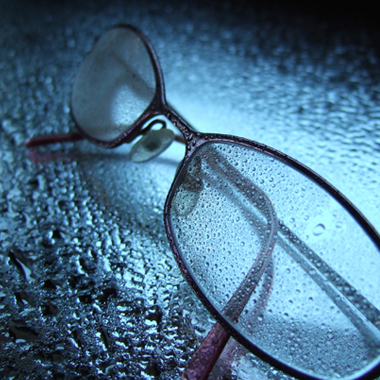
Myopia (short – sightedness)
Myopia is a very common eye condition. Objects in the distance appear more blurred, while closer objects are clearer. This is because either the power of the eye is too strong, or that the eye itself is too long.
Either way, the image of the object you see is formed before it reaches the retina, and so is blurred. Myopia is easily corrected with glasses or contact lenses.
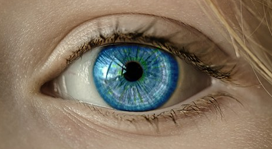
Hyperopia (long – sightedness)
Hyperopia is another very common eye condition. Objects in the distance appear generally clearer, while closer objects are blurred. This is because either the eye is not powerful enough, or the eye itself is too short.
Either way, the image of the object you see is formed after it reaches the retina, and so is blurred. Hyperopic people can increase the power of their eyes by accommodating and making the image clear, although this becomes more difficult as you get older or if you do a lot of concentrated work. Hyperopia is easily corrected with glasses or contact lenses.

Presbyopia
Presbyopia is caused when the eye gradually loses its ability to see objects up close. It happens to everybody from around the age of 40 and gradually continues from then on. The main reason for it occurring is that the lens in the eye becomes less elastic and harder to change shape, and so makes close objects look blurred.
As the changes happen so gradually, the effects are often not noticed immediately, but over time, reading may become more difficult – unless you hold a book further from you. Headaches may occur. Presbyopia is easily corrected using reading, varifocal, or bifocal glasses. Contact lenses are now also available.
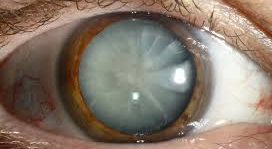
Cataracts
Cataract is a term used to describe the gradual ageing of the lens in the eye. When we are born the lens is perfectly clear and supple. As we age, the lens becomes more opaque and less supple. This has the effect of us needing more light in order to see as we get older, and objects generally appearing a little hazier.
Sometimes the lens can become so opaque that it affects the vision, and causes problems such as glare (especially at night). If this occurs, a short surgical procedure to replace the opaque natural lens with a clear artificial lens can be performed and your vision usually improves immediately.
At Hatch End Eyecare our optometrists are accredited by SpaMedica for post operative after-care appointments. This means that following your NHS cataract operation you are able to have the follow-up and discharge appointment here with us rather than visiting the eye hospital.
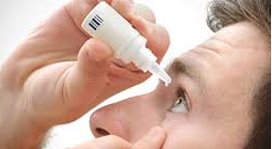
Dry eye
Dry eye is a condition where either the eye does not produce enough tears, or the quality of the tears do not lubricate the eyes sufficiently. This makes the eyes feel uncomfortable, gritty, and sometimes makes the white of the eyes appear very red. Dry eye can affect anyone at any time, although it is more common as we get older.
Confusingly one common symptom is the eyes watering excessively, especially in windy weather. Often, these symptoms can be relieved by using artificial tears to lubricate the eyes, although long term dry eye may need further investigation to rule out any general health conditions.

Diabetes
Diabetes is caused when the body is unable to properly regulate the amount of glucose in the blood. Symptoms can be very mild and so can be very difficult to spot. Long term poor control of diabetes can affect the eyes by causing changes to the blood vessels of the retina.
The blood vessels become more ‘leaky’ making them more prone to bleeding, causing possible risks to the sight of the eye. Generally the earlier any diabetic changes are noticed in the eyes, the better the outcome after any treatment and preservation of sight. Patients with diabetes are also more prone to cataract and macular changes, causing a reduction in vision. For this reason, diabetic patients are urged to have regular eye tests, and this is covered under the NHS.
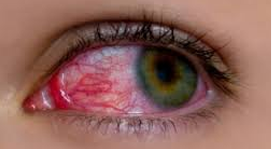
Glaucoma
Glaucoma is the name given to a group of conditions which cause progressive gradual degeneration of the optic nerve. Glaucoma is caused by a number of factors which can include high intraocular pressure of the eye, poor blood flow to the eye and genetic factors. Glaucoma affects the peripheral vision and often goes unnoticed by the patient.
Very rarely, glaucoma can affect people suddenly, making them feel sick and causing great pain to the eyes; in these instances immediate urgent attention is advised. Patients with glaucoma, or those with family members who have glaucoma, are advised to have regular eye examinations, and this is covered under the NHS
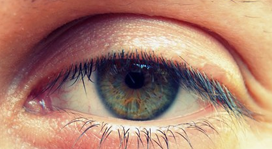
Macular Degeneration (ARMD)
Macular degeneration (or ARMD ‘ age related macular degeneration) affects the central area of the retina that deals with the most detailed vision and colour vision. It generally affects people over the age of 65 and causes deterioration of central vision. There are two main types; dry and wet.
Dry macular degeneration is far more common, progresses slowly and affects the vision more mildly. Wet macular degeneration is far less common, but happens over a short time span, and in extreme cases can cause total loss of central vision.
Astigmatism
Astigmatism is an eye condition that can occur in conjunction with myopia, hyperopia, or on its own. Astigmatism occurs when the front of the eye (cornea) is not perfectly spherical (often described as ‘rugby ball shaped’).
It causes the image of the object you see to be focussed at two different points, and so is blurred. Astigmatism is easily corrected using spectacles or contact lenses.
Floaters
The jelly middle part of the eye is called the vitreous. Tiny specks in the vitreous swirl around as you move your eyes. They are more noticeable on bright days or when looking at a high contrast background ie white wall, beach, blue sky or even the computer screen. Most people notice floaters in their vision at some point in their lives. Myopic patients tend to notice them more, and they are more common with age.
Most of the time, these floaters are perfectly normal ¦ but if you suddenly notice an increased number of floaters, (almost like a shower of floaters) or notice any flashes of light, or even a shadow or curtain closing across your vision, you should seek prompt attention. If the practice is closed and you are concerned it is wise to go to the nearest eye hospital for an emergency appointment. The Western Eye Hospital has a 24 hr unit, for full details and a map:
http://www.imperial.nhs.uk/westerneye/location/
Blepharitis
Blepharitis is an inflammation of the rims of the eyelids, which causes them to become red and swollen. Blepharitis is common, accounting for an estimated 1 in 20 eye problems reported to GPs. It is more common in patients over 50, although it can develop at any age. Symptoms include:
- burning, soreness or stinging in the eyes
- crusty eyelashes
- itchy eyelids
Blepharitis can be caused by a bacterial infection, or it can be a complication of a skin condition such as:
- seborrhoeic dermatitis, which causes an itchy rash on the skin and scalp (seborrhoeic dermatitis of the scalp is called dandruff)
- rosacea, which causes the face to appear red and blotchy
- itchy eyelids
Pre Treatment
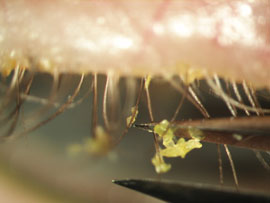
Post Treatment
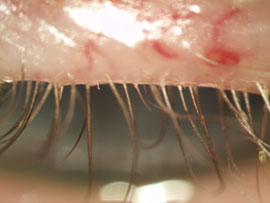
It is not possible to catch blepharitis from someone else who has it. Blepharitis is usually a long-term (chronic) condition, which means once it develops it can cause repeated episodes. Although there is no cure for blepharitis, our Optometrist can successfully descale the scurf and bacterial debris, the main causes of this inflammatory disease. This unique treatment takes 20-30 minutes and will massively reduce the debris, which may otherwsie take months to clean off using conventional home regimes. (More severe cases of blepharitis may require antibiotics)
Eye nutrition
Eating a healthy, balanced diet reduces your risk of eye disease. Include lots of omega-3 fats, found in oily fish, and lutein, found in dark-green, leafy vegetables such as spinach and kale.
Vitamins A, C and E are also helpful, so eat at least five portions of fruit and vegetables a day. If you have a family history of macular degeneration (losing central vision in the eyes), ask your optometrist about taking nutritional
Important information about eye nutrition

It is never too soon to take your child for an eye examination, as optometrists can examine children’s eyes even if they are unable to read letters. You should aim to take children for their first eye examination at least by the time they are three years old, especially if there is a family history of wearing glasses.
Children should have eye examinations at least once every year, and more often, as advised by the optometrist, if they have an existing eye condition. Eye tests for children under 16 are free, and also upto 18 and in full time education. It is important to know that the eye screening children receive in schools is not as detailed as the eye examination carried out by an optometrist. A recent study has shown alsmost a third of schools have no facility for screening their pupils!
Always make sure there is plenty of light when your child is doing their homework so they do not strain their eyes to see. An Anglepoise lamp or an overhead white light is very useful.
Children of any age who are underachieving at school should have an eye examination. Poor vision is very likely to cause problems with reading and writing.
If you suspect that your child has a colour vision problem or if there is a family history of colour vision problems then arrange an eye examination with our optometrist. There is no cure for colour vision deficiency but at least teachers can be made aware of this problem and avoid using certain colours in their teaching.

Always protect your child’s sight in the sun. There is increasing evidence to suggest that over-exposure to the sun’s ultraviolet rays (UV) can contribute to the development of cataracts, age-related macular degeneration and ocular melanoma (eye cancer). On average, people receive 50% of their lifetime sun exposure before they are even 18 years old!
Make sure they eat their greens! Eating certain fruit and vegetables which contain substances called lutein and zeaxanthin help protect against some eye conditions, in particular cataracts and age-related macular degeneration, the leading causes of blindness in this country. In particular ensure they eat plenty of broccoli, oranges, carrots, kiwi fruits, mangoes, sweetcorn, grapes, and of course spinach!
If your child is computer crazy or a bookworm ensure they take regular breaks from such close work.
Children who rub their eyes a lot or who complain of tired eyes and frequent headaches should have an eye examination. Poor vision is a common cause of sore eyes and headaches.
When your child is playing certain sports, such as badminton or squash, get them to wear protective goggles so they don’t risk a dangerous eye injury. These can be obtained from our practice and can even have a prescription built in.


